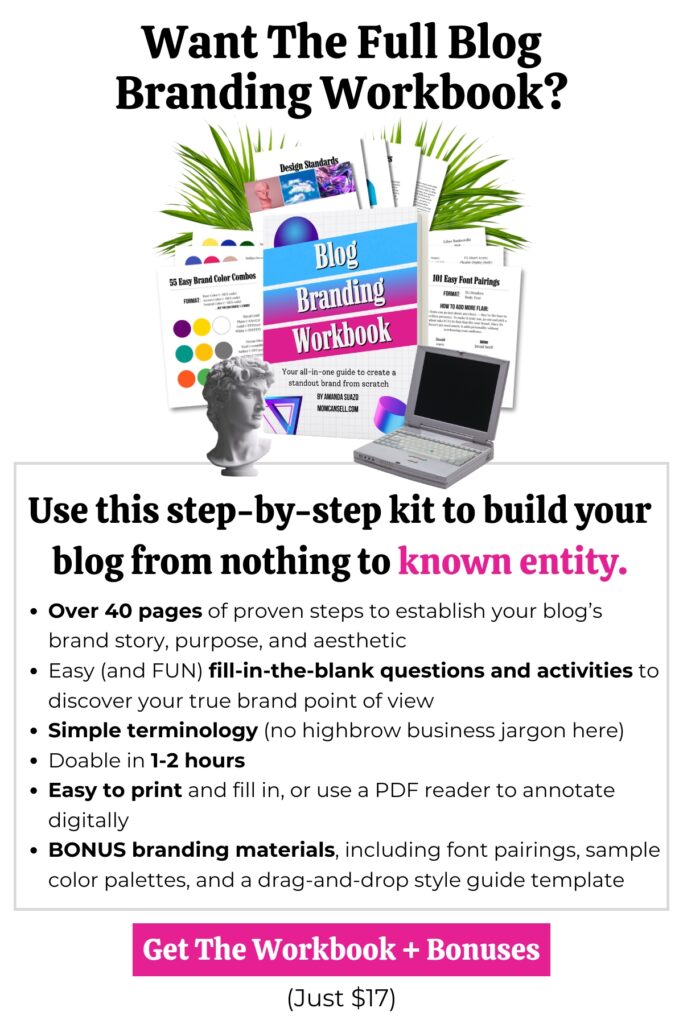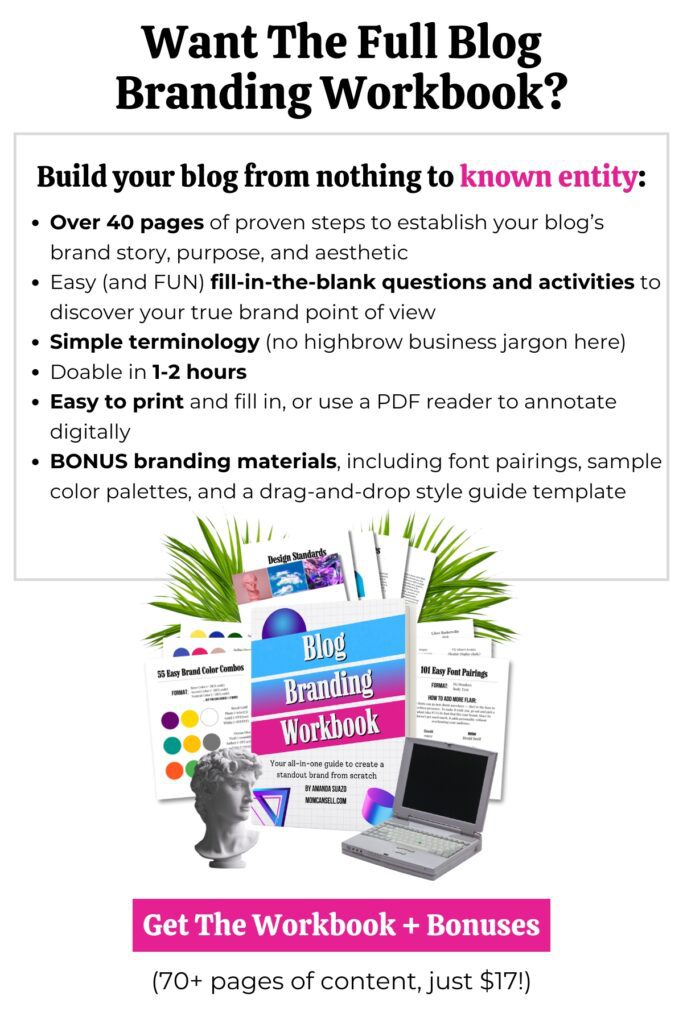The most ambitious new bloggers launch so fast that they think blog branding (or a blog branding kit) just means throwing together a few pretty colors and fonts and calling it a day. But if you want to learn how to build a brand online that lasts for years to come, there’s way more to it than that!
After marketing blogs for over a decade, building several brands from nothing, and spending years enforcing brand guidelines for established bloggers, I’ve learned that setting up your blog brand is SO important if you want it to have a strong foundation.
Branding blogs the right way can help you:
- Establish authority in your chosen blog niche
- Stand out from your competitors
- Build a better media kit
- Connect with your audience, build trust, and encourage loyalty
- Become instantly recognizable to strangers and potential clients
- Put your best foot forward when you pitch to brands
- Answer process questions if and when you eventually build a team or hire outside contractors
You can work on creating a personal brand identity, or a brand that can go beyond just “you” as it grows. And I’ll show you how!
What Is Brand In Marketing?
“Brand” is the way a person recognizes your business without you having to tell them upfront.
It goes beyond colors and fonts. Successful blog branding coordinates written and visual elements to show a consistent voice and point of view across every platform where it shows up.
Brand shows people who you are, who you serve, and the value you can deliver to them.
You might know (or have an idea of) different components for branding your blog – but this blog branding kit will help you weave them together intentionally to send a crystal clear message to your audience.
How To Build A Blog Branding Kit
Now that you understand the importance of brand identity, it’s time to build one!
Here are the essential steps you need (in this order) to create an effective blog branding kit.


1. Identify your core values and mission
Maybe you started a blog as a personal creative outlet – that’s okay! If you’re learning how to build a brand online, though, chances are you blog because you want to help people in some way.
Having a mission will influence everything from content strategy to how you show up on social media, so give these questions extra thought and care:
- Why is your blog here?
- What does it stand for?
- What values does it represent?
- What mission is it trying to accomplish?
Need examples of branding like this? Check out my about page or about pages for any brand you admire, blogger or otherwise. The best ones articulate these points so well that anyone can understand them.
This is also a great time to develop a tagline – basically a mini version of your mission that people can easily remember.
Mine is “make your mom blog a business.” It’s short, simple, and easy to recognize.
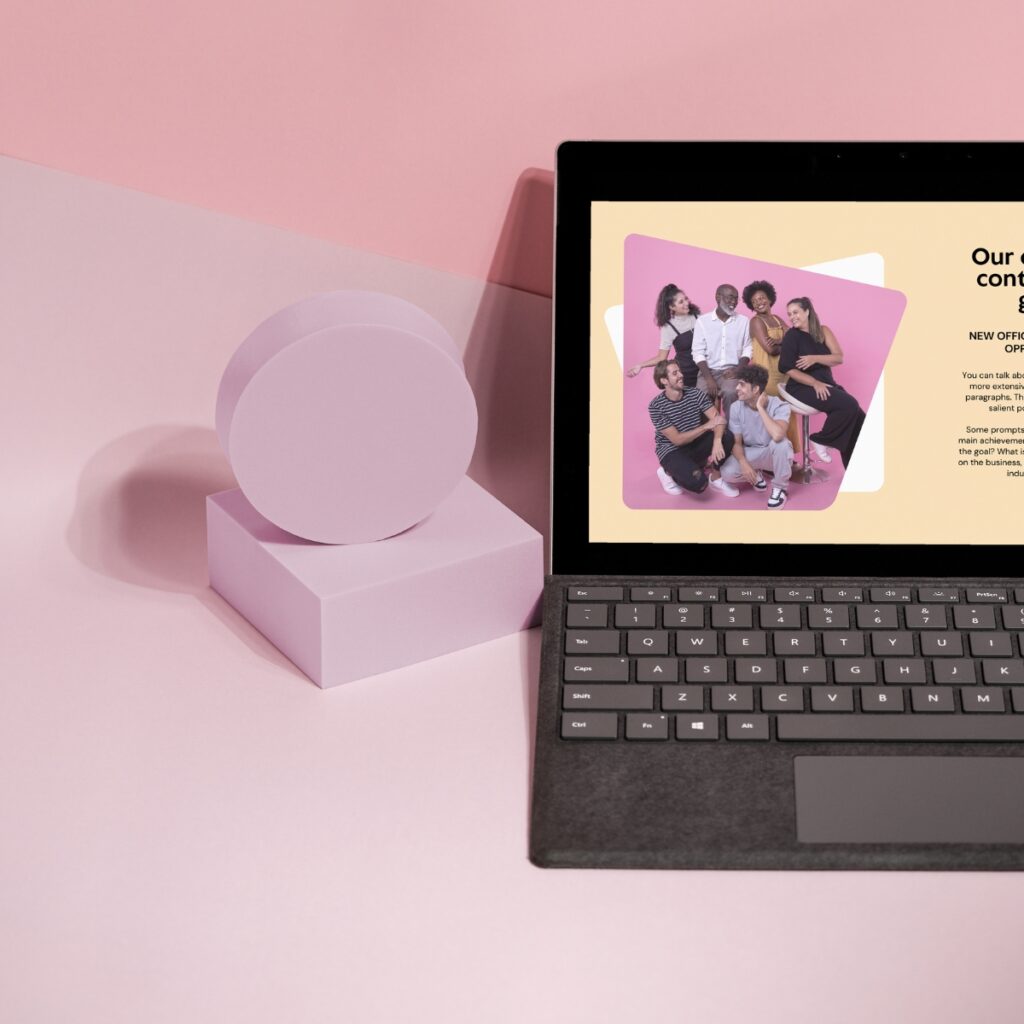

2. Understand your target audience
You established the “why” in your blog branding process – now it’s time for the “who.” Your audience!
Just like when you choose a blog niche, you need to understand that your blog can’t serve everybody. You’ll end up juggling too many priorities and end up helping nobody instead.
That’s why you need to narrow down your target audience, including:
- Demographics such as age, location, education, religion, gender, income, employment
- Where they spend their time (online or otherwise)
- Typical problems they experience
You’ll be able to serve them better and get closer to their biggest problems and how you can solve them.
For example, my target audience is mom bloggers and influencers in the US that want to grow their blogs into an income-generating business. Hopefully that’s you. 😉
My best branding tip? Pick an audience you can easily target and survey. Maybe they live in Facebook groups, subreddits, in-person communities, or somewhere else – just make sure you can find them easily.
Why? Not only is it easier to understand their pain points if you observe them as a whole, but they’ll also be easier to target if and when you decide to sell physical or digital products.
If you niche down too much with your audience, you might not be able to find enough of them to make your business viable in the long run.
If you already have an established email list, this is the perfect time to ask your audience directly about their problems and what they’d like to see from you to solve them. You’d be surprised at the ideas they come up with – and the solutions you can create that generate income!


3. Define your unique value proposition
Nobody can do your brand like you. But, you need to be able to explain what makes it different from your competitors.
What are the unique benefits of your blog? How will your blog experience stand out from others? What do you give readers that’s different?
Some influences you can use to shape your unique value proposition include:
- Professional experience
- Life experience (bet you got some great stories!)
- Frameworks you use to get the job done
- How you explain complex topics
- Your eye for aesthetics
- The way you rally people together
If I’m trying to build my brand, it should be as unique as me. Even if the blog doesn’t show my face very much or use my name as the brand name, it still directly reflects my personality, experience, and point of view.
You’re the secret sauce behind your brand, so use that to figure out the unique value you offer.
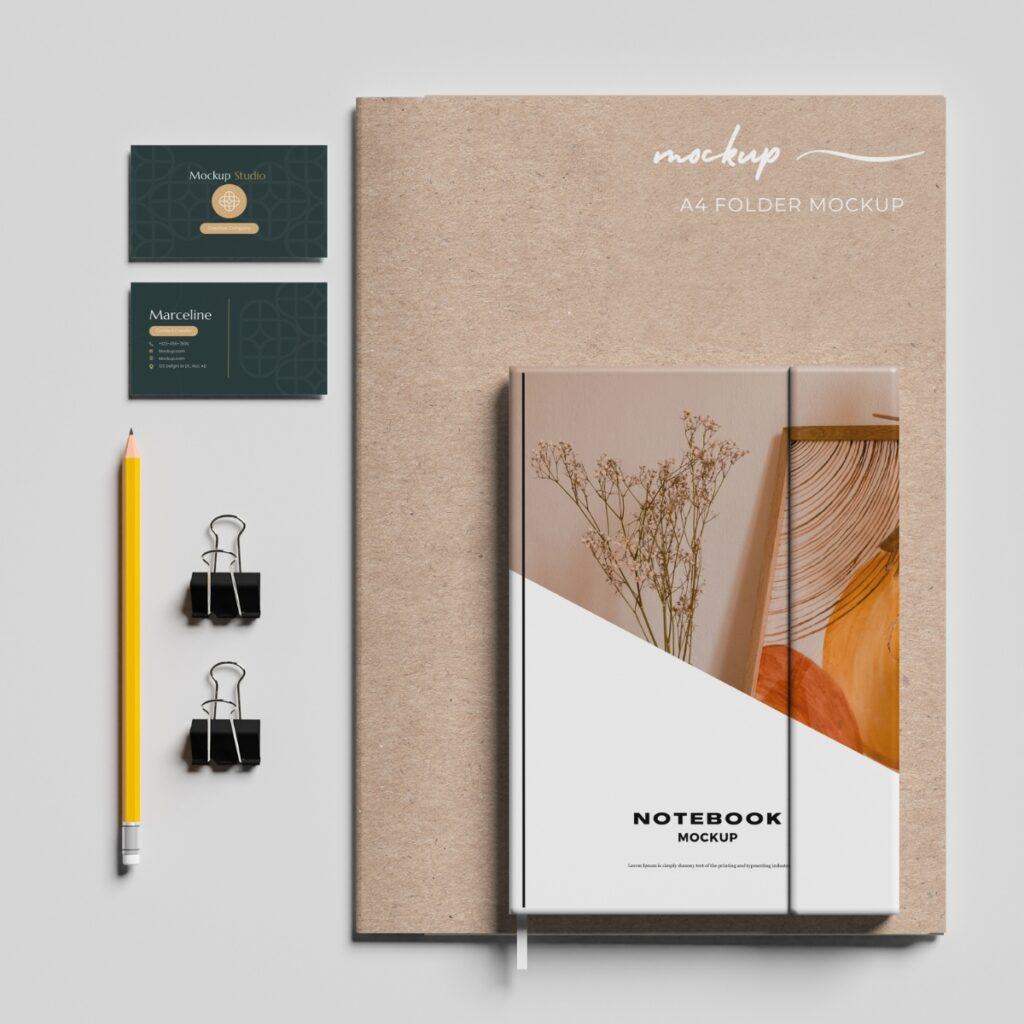

4. Build your visual identity
As someone who enjoys design, this is the fun part of how to build a brand online!
Your blog branding kit needs to include a full range of visual elements, including:
- Logo – The text, colors, shapes, and illustrations that show your blog’s name and purpose
- Colors – Including a consistent color palette that reflects your brand’s personality (use color psychology to help you choose!)
- Typography – Fonts that reflect your brand tone (Professional? Fun? Chic?)
- Imagery – How your photos look (Light and bright? Moody? High contrast? Colorful? Minimalist?)
Of all the self branding tips you could read here, this one is key: Keep your visual identity consistent! If you’re learning how to build a brand online, it’s the only way you can stay recognizable across all the channels where you show up.


5. Develop your brand voice and tone
How do you – and your brand – communicate?
If you’re a lawyer selling your professional services, maybe you want to sound clear and informative. If you talk about parenting, maybe you want to sound gentle and understanding. If you talk about the silly side of being a mom, maybe you want to sound a little snarky or witty.
Your brand voice should stay consistent across platforms and stay true to your values.
The tone may vary depending on your topic, but the overall “personality” behind your writing should stay the same in the branding process.
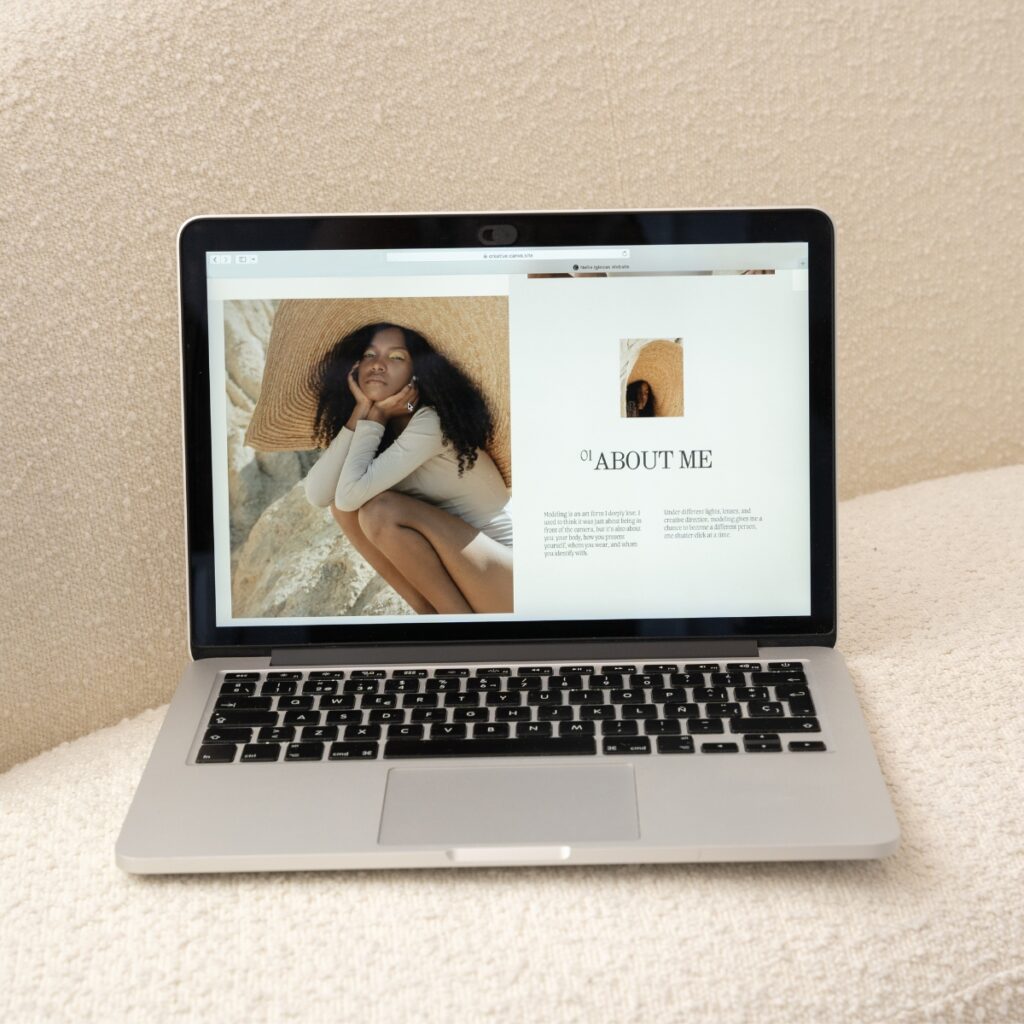

6. Optimize your website design
Now that you have visual elements in your blog branding kit, it’s time to apply them to your blog!
And we’re not just talking about slapping your logo on the nav bar. Every element of your website contributes to user experience and brand perception.
Those elements can include (but are not limited to):
- Header and body text fonts
- Button shape, sizing, and color
- Hyperlink colors
- Photo aesthetics
- Icons
- Product styling and photography
This is the time to let your branding blog skills shine. Don’t settle for a boring look!


7. Stay consistent with your community
We know by now that quality blog branding can help you stay recognizable on and off your website.
That means, on all the channels where you show up off your blog, you need to have a consistent brand presence.
Take a close look at your social media channels, email newsletter format, and even how you communicate with your followers.
Do all these pieces align with your core values, your brand tone, and your brand aesthetic? Have people come to expect a certain look or value from your social posts? Do they find it consistently? Do you “sound” the same everywhere your brand goes online?
I’ve seen several influencers present themselves as friendly and helpful on their blog, but then lose control with commenters on social media and get sarcastic or even rude. It’s frustrating to deal with haters (you know you’ve made it when you have a couple), but responses like this won’t serve your brand identity.
Evaluate how you might deal with situations like this and have processes in place for keeping your brand consistent with your community.


8. Monitor and adapt your branding strategy
As your audience grows – and as you grow as a blogger and influencer – some parts of your blog brand kit may not fit anymore.
That’s okay! Change is inevitable. One of the beautiful things about individual branding for bloggers is that it can adapt with you.
Even the biggest name brands go through logo changes, color tweaks, and even voice adjustments. You can too.
But how do you know when it’s time to change? Here are a few ways to tell:
- Your audience has changing needs (which you can figure out with through regular communication with them)
- You’ve grown so much that you can expand your niche to a more general audience
- Blog analytics or audience surveys show that your audience prefers some elements of your brand over others
- Some part of your brand doesn’t personally resonate with you anymore
Make note of the specific items you want to change and be sure to carry out those changes across all the platforms we’ve discussed above. You can always make changes – just keep them consistent and make sure they still serve your audience and mission.


9. BONUS TIP: Create a style guide
From my experience creating style guides for multiple blogs, I must say: It’s one of the best ways to keep track of all the aspects of your blog brand kit.
A style guide collects all the elements of your brand into one place. You might want to include things like:
- Audience avatars
- Color schemes
- Fonts
- Proper uses of your logo
- Voice guidelines
- Website element styles
- Photography and videography standards
- Social post layouts and/or templates
While design sites like Canva offer a basic style guide, I like to put these standards in a more extensive document design so I can capture all the elements more thoroughly and share them with a wider range of people.
A style guide helps you keep track of all these components, but it’s even more helpful if your team expands. You can communicate your brand’s essence to newcomers in one place, and change them here as your brand evolves.
How To Create Blog Branding Assets
So – who’s going to make your blog branding kit? You have a few options.


1. DIY your blog branding
There are lots of good reasons for creating your own brand from scratch:
- You’re a beginner
- Your blog has a tight budget
- You want to learn branding skills for yourself
- You’re branding on the fly and answering questions about it as you go
Although it takes time, you get to keep full control of your brand this way. Staying this close to the brand creation process helps you get a better handle on what your blog stands for and who you’ll serve.
2. Outsource your blog brand
Most new bloggers won’t take this approach because the expenses can rack up fast. But, in theory you can outsource all the aspects of building your brand online to someone else.
The pros? It’s like hitting one giant easy button. Faster, easier, and you may feel like the results look more professional.
To be honest, though, I don’t know a single blogger who would take this approach. They’re all so personally entwined with their brands that handing that control off to someone else doesn’t make sense.
And let’s not forget – outsourcing is expensive and you’ll still have to make sure all the people you hire are aligned with your vision. I have seen brand experts charge in the thousands for done-for-you services, but why take the risk if nobody knows your brand better than you?


3. Take a hybrid approach
Nobody’s good at everything – so to save time learning how to build a brand online, you can hire some help for the toughest tasks.
“Tough” varies depending on the person. For you, that might mean hiring a freelance writer, web designer, or photographer. For others, they might find a graphic designer or videographer.
In my own experience, I can take a decent photograph, but it takes forever so I look at stock sites like Ivory Mix or Élevae Media to save time (they have great free and paid stock photos).
I also love design but I’m not that good at designing websites, so I chose Showit as my website builder without the added cost of a web designer (you can try them free for a month with my link)!
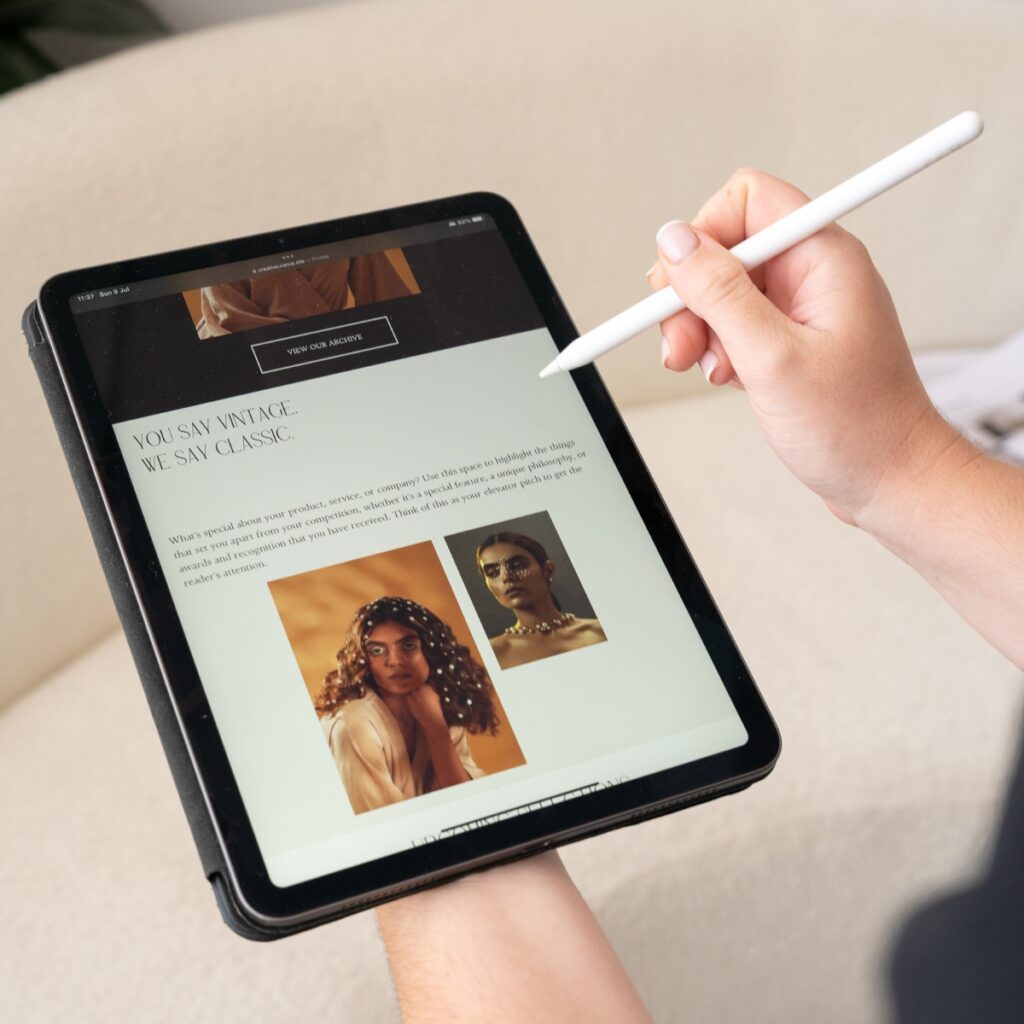

What Is Your Personal Brand Vs. Business Brand?
We’ve talked at length about how to build a brand online, but I need to make one more distinction.
There are two kinds of brands you can build: A personal brand or business brand.
Why build a personal brand? Most bloggers take this approach because you are the brand. The brand strongly associates with you, your expertise, and your experience. Without you, the brand wouldn’t exist.
The best examples of personal blog brands are the ones that use an individual’s name. It works well for highly individualized businesses like coaching or freelancing.
The drawback to a highly personal brand is that if something happens to you, it inevitably affects the brand. If you run into personal image branding issues such as a PR crisis, health problems, or having to take a leave from blogging, your brand suffers.


On the other hand, a business brand represents a separate organization from its creator or staff. It may feel less intimate than a personal brand, but it won’t depend so strongly on YOU to keep it afloat. The other benefit to a business brand is that you can sell it if you decide to pursue other ventures.
If you’re just getting started with your blog branding kit, this is a great time to think about what kind of brand you want to build.
Your Turn: Try A Done-For-You Blog Brand Kit
Learning how to build a brand online takes more effort than you may have realized, but it doesn’t have to be hard. I put together a Blog Branding Workbook that removes all the guesswork from the process. It uses the same foundations as the household-name brands you know, but with an easy fill-in-the-blank format (and affordable price). Use it to capture your brand on paper, both for yourself and anyone else you bring on board with your vision.



